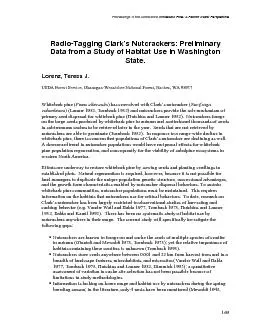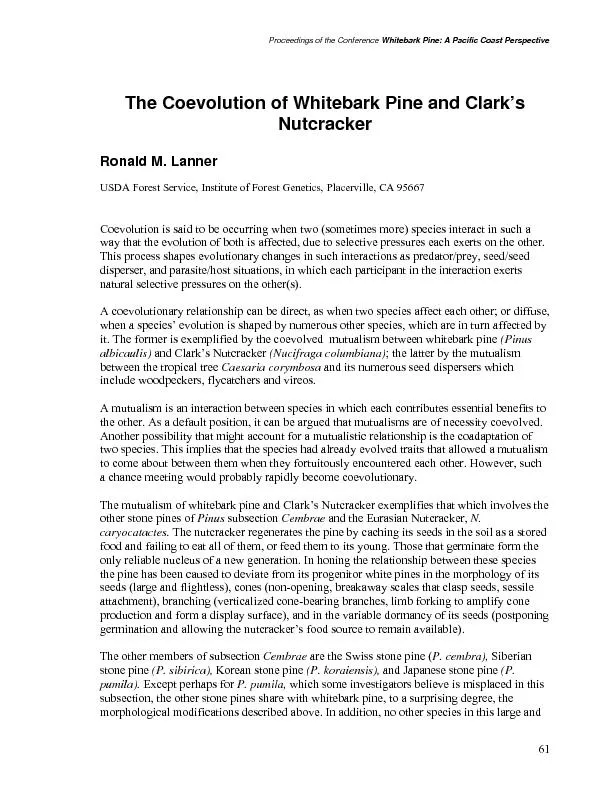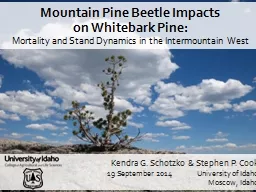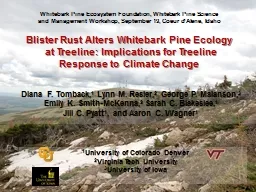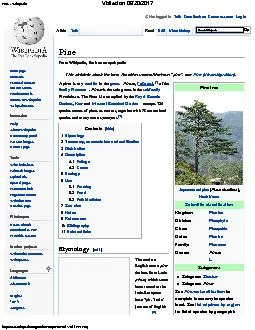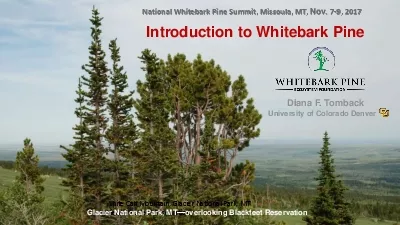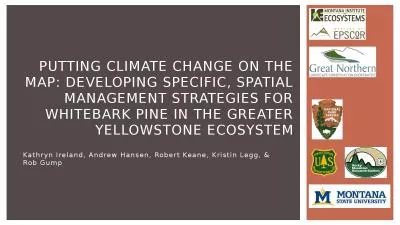PDF-Proceedings of the Conference Whitebark Pine: A Pacific Coast Perspect
Author : natalia-silvester | Published Date : 2015-09-13
USDA Forest Service OkanoganWenatchee National Forest Naches WA 98937 Lanner 1982 Tomback 1982 and nutcrackers provide the sole mechanism of primary seed dispersal
Presentation Embed Code
Download Presentation
Download Presentation The PPT/PDF document "Proceedings of the Conference Whitebark ..." is the property of its rightful owner. Permission is granted to download and print the materials on this website for personal, non-commercial use only, and to display it on your personal computer provided you do not modify the materials and that you retain all copyright notices contained in the materials. By downloading content from our website, you accept the terms of this agreement.
Proceedings of the Conference Whitebark Pine: A Pacific Coast Perspect: Transcript
USDA Forest Service OkanoganWenatchee National Forest Naches WA 98937 Lanner 1982 Tomback 1982 and nutcrackers provide the sole mechanism of primary seed dispersal for whitebark pine Hbark p. Where to Gather Pine NutsPinon pines may be found throughout the GreatBasin. They cover slopes above the valley floor andbelow higher elevations. The abundance of the nutsvaries by year and geographic /. Winter Ecology . /. Spring 2010. Foundation Conifer of the Subalpine . Forest. Limber Pine / . Pinus flexilis. Mountain Research Station . – . University of Colorado, Boulder. What winter adaptations has the Limber Pine developed that contribute to its range and resilience ?. Hunting/diet - Fishing. Pacific Salmon. Humpback Whale. Oysters . Crab. Turtle. women prepared fish in two ways: some fish was eaten fresh, but most of it was dried and saved for the winter months. Hunting/diet - Land. Ronald M. Lanner 61 USDA Forest Service R6-NR-FHP-2007-01 variable genus share the cone modifications that characterize the stone pines. This is true even of other bird- or mammal-dispersed pines l Terpene. Biofuels & Renewable Chemicals. Jennifer . Lauture. , MSc Student. Gary Peter. , . Professor. School of Forest Resources & Conservation. Alan . Hodges, . Extension Specialist,. Food . Results of monitoring blister rust and competing vegetation in 5 . northern. . Idaho sites from 1995- 2012. John Schwandt, . Holly Kearns, and Jim Byler. Project Purpose. Monitor natural WB regeneration over time. Schotzko. & Stephen P. Cook. 19 September 2014 University of Idaho. Moscow, Idaho. Mountain Pine Beetle Impacts . on . Whitebark. Pine: . Mortality and Stand Dynamics in the Intermountain West. With Central Coast Domestic Services you can do regularly carpet cleaning central coast with our professional annual cleanup you can keep fabric fresh and hygienic and we guarantees the safe removal of harmful mites and bacteria which are proven to be common contributors to allergies. Fabric life is also maintained meaning you can prevent expensive replacement costs at a later date. Pacific Salmon. Humpback Whale. Oysters . Crab. Turtle. women prepared fish in two ways: some fish was eaten fresh, but most of it was dried and saved for the winter months. Hunting/diet - Land. Black-tailed deer. Investment Potential for Longleaf Pine. Lumbermen have long realized the value of longleaf products like high quality, straight grained dimensional lumber and strong durable poles.. Longleaf . was regarded as a poor . Pine Ecology. at . Treeline. : Implications for . Treeline. . Response to Climate Change. 1. University of Colorado Denver. 2. Virginia Tech University. 3. University of Iowa. Whitebark. Pine Ecosystem Foundation, . Pine Pine tree Japanese red pine (Pinus densiflora),North KoreaScientific classificationKingdom:PlantaeDivision:PinophytaClass:PinopsidaOrder:PinalesFamily:PinaceaeGenus:PinusL.Subgenera Subgenus Stro WhitebarkPineDiana F TombackUniversity of Colorado DenverNational WhitebarkPine Summit Missoula MT Nov 7-9 2017White Calf Mountain Glacier National Park MTView Blackfeet ReservationGlacier National Pa PUTTING CLIMATE CHANGE ON THE MAP: DEVELOPING SPECIFIC, SPATIAL MANAGEMENT STRATEGIES FOR WHITEBARK PINE IN THE Greater Yellowstone Ecosystem. Whitebark. pine mortality. Keystone species. 80% mortality rate within the adult population .
Download Document
Here is the link to download the presentation.
"Proceedings of the Conference Whitebark Pine: A Pacific Coast Perspect"The content belongs to its owner. You may download and print it for personal use, without modification, and keep all copyright notices. By downloading, you agree to these terms.
Related Documents

